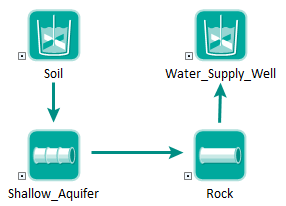
A model of an environmental system is created by linking pathway elements together into a pathway network, as shown below:

GoldSim moves mass through the network, keeping track of the temporally varying amount of mass in each pathway.
To create such a network, individual pathways are connected via mass flux links. A mass flux link controls the rate at which species are moving between pathways. The mass flux is a vector by species (i.e., it has one item for each species), since the flux will differ for each species being simulated, and has dimensions of mass/time.
 Note: The Contaminant
Transport Module relies heavily on GoldSim's ability to create and manipulate
vectors.
Note: The Contaminant
Transport Module relies heavily on GoldSim's ability to create and manipulate
vectors.
Two major types of mass flux links and three special purpose mass flux links can be defined in GoldSim. In an advective mass flux link, a quantity of a medium is specified to flow from one pathway to another, carrying dissolved, sorbed, and/or suspended species with it. In a diffusive mass flux link, species diffuse between pathways according to a concentration gradient. Three special purpose mass flux links allow you to model processes that cannot be represented as using advection of diffusion. In a direct transfer mass flux link, species are moved from one pathway to another based on a user-specified transfer rate. In a precipitate removal mass flux link, species present as precipitated mass are moved from one pathway to another based on a specified transfer rate. In a treatment mass flux link, species are treated or filtered and are moved to from one pathway to another based on a specified treatment efficiency (a fraction).
Based on the properties of each pathway, the media in each pathway, the species, and the specified mass flux links, GoldSim computes the amount of mass in each pathway, the concentrations in each pathway's media, and the mass fluxes between pathways, all of which vary with time. Hence, the fundamental output of a pathway element is a series of vectors: the mass (of each species) in the pathway, the mass flux (of each species) to each of the pathways to which it is connected via mass flux links, and the concentrations (of each species) within the environmental media in the pathway.
Learn more about: